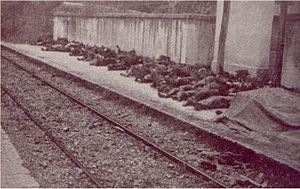Balvano train disaster

Some of the corpses gathered in the Balvano railway station
|
|
| Date | 3 March 1944 |
|---|---|
| Time | after 00:50 AM |
| Location | Balvano, Basilicata |
| Country | Italy |
| Rail line | Battipaglia–Metaponto railway |
| Operator | Ferrovie dello Stato Italiane |
| Type of incident | Carbon monoxide poisoning |
| Cause | excessive weight; bad quality coal; lack of natural ventilation in the tunnel |
| Statistics | |
| Trains | 1 |
| Deaths | 517 (official figure by Italian Government) |
| Injuries | 90 poisoned |
The Balvano train disaster was the deadliest railway accident in Italian history and one of the worst railway disasters ever. It occurred on the night between 2-3 March 1944 in southern Italy, near Balvano (Basilicata). In the event, some 426 people illegally riding a steam-hauled freight train died of carbon monoxide poisoning when the train stalled on a steep gradient in the "Galleria delle Armi" tunnel (English: Armi tunnel).
Naples suffered severe wartime shortages, encouraging an extensive black market. By 1944, the Allies had already defeated the fascist government of Benito Mussolini. Opportunists in the city began bartering fresh produce for commodities brought by servicemen, and stowed away on freight trains to reach their suppliers' farms. The railway companies also experienced shortages of good-quality coal. The burning of low-grade substitutes produced a large volume of carbon monoxide which is an odourless, poisonous gas. This was a critical factor in the ensuing disaster.
At 7 PM on 2 March 1944 the freight train 8017 started from Battipaglia heading to Potenza on the Battipaglia–Metaponto railway. The train, hauled by two locomotives (in first position the 480.016, and then the 476.058), had a mass of 520 tonnes and also carried many illegal passengers, making it grossly overloaded. In Eboli some of them were forced to get off the train, but more boarded on following stops. At 00:50 AM the train left the station of Balvano, the last one before the disaster.
On the steeply graded Armi tunnel the train stalled with almost all the cars inside the tunnel. The passengers and crew were overcome by the smoke and fumes so slowly that they failed to notice the dangers. Most passengers died in their sleep and were found still in their resting position. Most of the few survivors were in the last few cars which were still in the open air. Rescuers later found that the driver of the 480.017 had tried until the last to restart the train in the forward direction, while the driver of the 476.058 locomotive at some point tried to engage the reverse gear in attempt to exit the tunnel; the two drivers were unable to communicate because the 476 was an Austrian-built locomotive with right-hand drive, while the 480 had left-hand drive. Much carbon monoxide gas was produced as a by-product of combustion, and carbon monoxide poisoning is a well recognized danger when machines are used, or fires occur, in enclosed environments. It combines with haemoglobin when inhaled, so the victim dies of anoxia (lack of oxygen). It is still the principal cause of death in mine disasters after a fire or explosion.
...
Wikipedia
